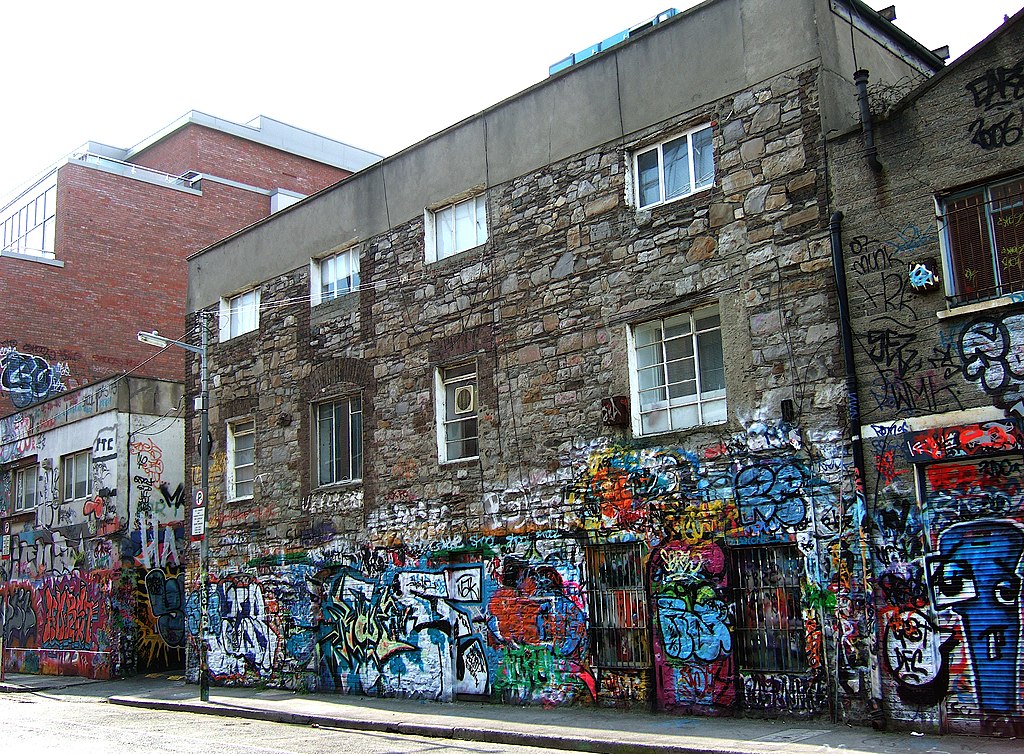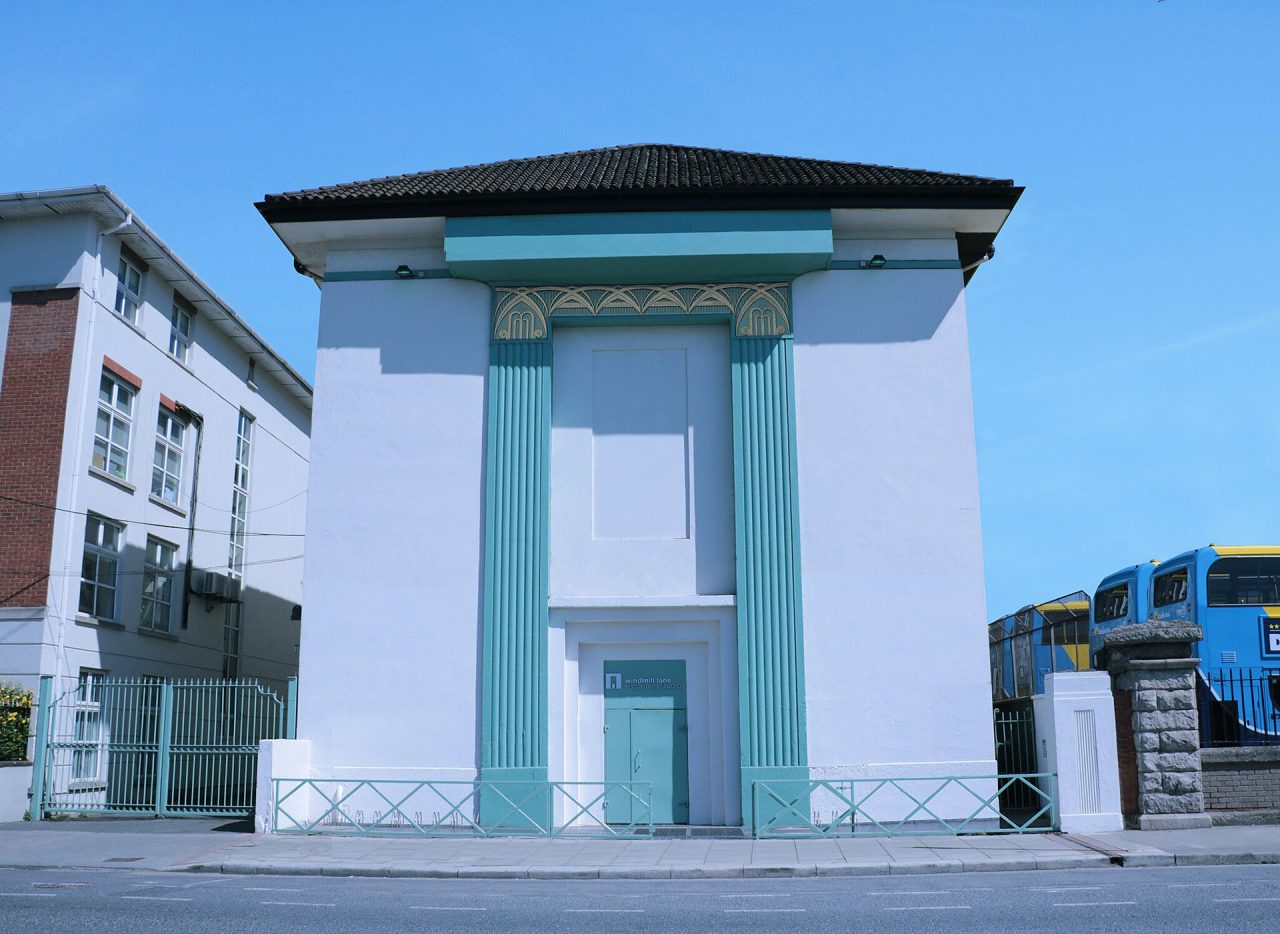The famous Windmill Lane Studios are currently located in a striking art-deco style building on 20 Ringsend Road in Dublin 4.
The original building
The studio was founded by Brian Masterson and James Morris in 1978, and started out on Windmill Lane on the corner with Creighton Street. It was originally primarily used to record traditional Irish music sessions. There Planxty recorded After the Break, The Woman I Loved So Well, and their final album, Words & Music, between 1979 and 1983.
But Windmill Lane Studios is probably best known as the recording studio for U2. Their first album, Boy, was recorded there, and the iconic red exterior of the original Windmill Lane building became synonymous with U2’s early career. Interestingly the drums on Boy were recorded in the reception area:
So the studio crew were very surprised when I decided I wanted to record the drums out in the hallway by the receptionist, as there was this wonderful clattery sound I wanted to get.
But that meant we couldn’t record until the evening, because this girl was sat answering the phones all the day. Even then, we couldn’t turn the ringer off the phone so occasionally it would go off mid-take.
Steve Lillywhite
After U2 recorded two more albums, October and War, the studio gained a wider audience. Clannad recorded Legend, Status Quo recorded Just Supposin’ and Never Too Late. Kate Bush partially recorded her albums Hounds of Love and This Sensual World. A few more artists using the studios were The Waterboys, Steve Winwood, Def Leppard, AC/DC, Van Morrison, and of course, U2 continued to record there.
In 1990, the main studio moved to a new location on Ringsend Road, also in the Docklands.
The old studios had by this point turned into a bit of a U2 shrine with one of walls being completely covered in graffiti from visiting fans. For years the wall and studios were still a popular tourist destination, and the building was still used for video and audio post production and other related services.

But in 2008 plans were submitted to turn the studio and buildings around it into a seven storey office complex, and the remaining companies left in the building started moving out soon after. The building crash of 2008 stopped any development plans for a while, but any attempts to preserve parts the studio and the graffiti wall as a tourist destination failed, and in 2015, the buildings were demolished and replaced by a six storey office building.
The new building
The new building has an interesting history in its own right. It started out as an electrical power station for the tramline depot, was used as a Bovril factory, and in the 70s it was turned into a high-end snooker hall. The exterior remained the same, but inside it now houses three studios.
The new studio continued to attract a diverse range of artists, from established legends like David Bowie, the Rolling Stones, and Bruce Springsteen, to emerging talents, fostering an environment where creativity thrived. Orchestras regularly record their music at Windmill Lane Recording Studios, as Studio One is the only recording room in Ireland, apart from RTÉ, that can record an 80-piece orchestra.
In 2006 Brian Masterson and James Morris sold the studio to Van Morrison who had previously already used the studio for several of his albums. But he didn’t keep the studio for very long, and in 2009 the current owners, Naomi Moore, Aidan Alcock and Tony Perrey bought the studio and updated the equipment.
In addition to the famous musicians who record their albums there, the studio also recorded scores to many movies: Mission Impossible, Sing Street, A Room with a View, The Remains of the Day, The Mask, The Tailor of Panama, The Grifters, My Left Foot, In America, A River Runs Through It, and more recently, Disenchanted and Overboard.
In 2020, they launched a visitor’s experience that allows visitors to discover the history of the studio, find out how music tracks are put together, and mix their own session. It closed almost immediately due to Covid-19, but has reopened since. One of the reasons the owners created this experience was because of a lack of awareness of the studio’s significance, and that they’ve been in the new building for more than 30 years now while people still look for them on the old Windmill Lane location.
People still associate us with [being] down in the original Windmill Lane, the building itself was demolished recently, people were emailing us saying the business is gone, not realising we’ve been in Ringsend for thirty years.
Naomi Moore, in Newsfour.ie
Sources: Windmill Lane Studios website, Wikipedia, Dublin Live, Newsfour.ie, HotPress.
Images:
– Current building: Aidan3630, CC BY-SA 4.0 https://creativecommons.org/licenses/by-sa/4.0, via Wikimedia Commons
– Original studio: Joho345, Public domain, via Wikimedia Commons
